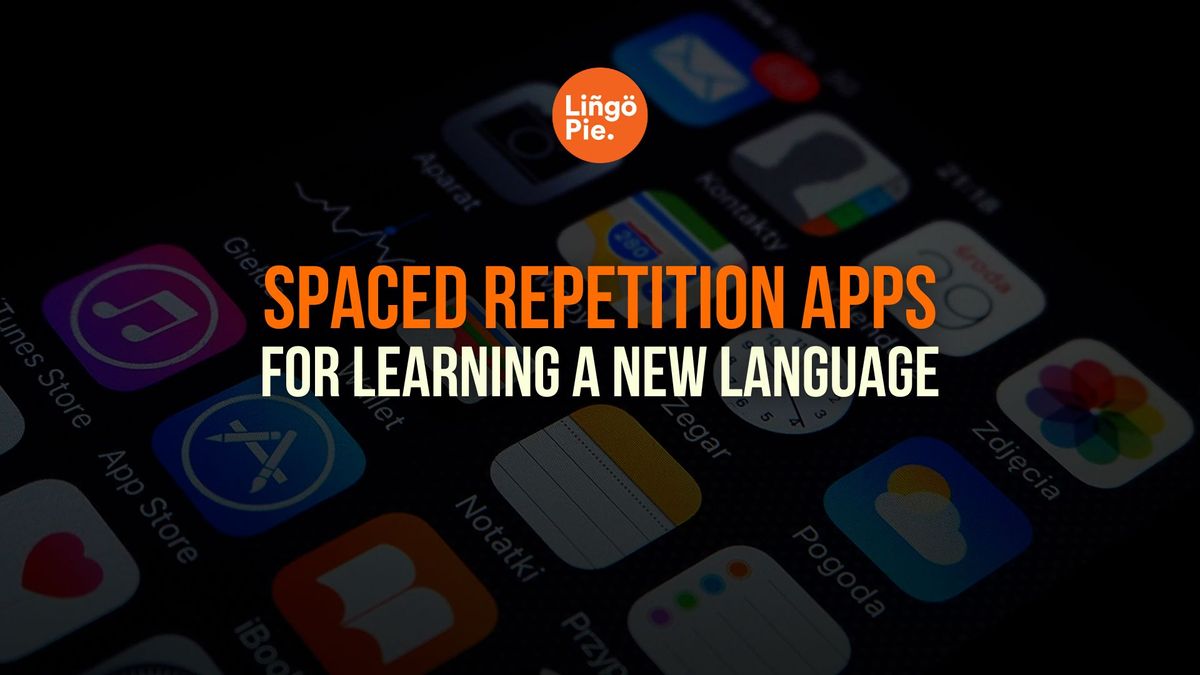Ever tried learning a language with traditional flashcards? If you have, you probably know the feeling – that mix of determination and frustration as you watch your perfectly organized stack slowly transform into a jumbled mess of bent cards and coffee stains. And let's talk about that moment when you accidentally knock them off your desk... pure chaos!
If you're serious about learning a language, it's time to upgrade those paper cards to something smarter. Language apps with spaced repetition features are specifically designed to show you words and phrases at the perfect moment when your brain needs a refresh. No more guessing when to review; these apps are hardwired to track your learning patterns and serve up vocabulary right when you're on the edge of forgetting it.
In this post, we're diving into 8 brilliant spaced repetition apps that are revolutionizing language learning. After testing each for 3 months, we can guarantee that these spaced repetition apps will adapt to your learning style, track your progress, and turn language practice into a science-backed strategy for success.
- English or Spanish: 11 Surprising Differences
- How To Become Fluent in Spanish: 5 Best Tips [2025]
- 5 Easiest Asian Languages To Learn: Ranked

What is Spaced Repetition?
Spaced repetition is a powerful learning method that strategically schedules review sessions at increasing intervals to maximize long-term memory retention. It's become one of the most popular features in modern language learning apps, transforming how we approach vocabulary practice and memorization. Instead of reviewing everything daily, the system tracks which words you know well and which ones need more practice, then adjusts your review schedule accordingly.
How Does Spaced Repetition Work?
Let's say you're learning the Spanish word "ventana" (window). The first time you see it, you might review it again in 24 hours. If you remember it correctly, the app might wait three days before showing it again. Get it right again? Now you might not see it for a week. But if you struggle with it, the app brings it back sooner – maybe the very next day.
In short, spaced repetition ensures that you're not wasting time reviewing words you already know well. Instead, it makes sure that you're getting extra practice with the ones you find challenging – exactly when your brain needs it.
Best Spaced Repetition Apps For Language Learning
Spaced repetition's effectiveness isn't just theory – it's proven by research. In fact, a 2015 study found that students who waited eight days between learning and review outperformed those who reviewed after just one day. Testing their knowledge five weeks later showed definitively that spacing out review sessions leads to better long-term retention.

Ready to put this science to work in your language learning? We've selected 8 top spaced repetition apps that will help you master vocabulary faster and remember it longer. These apps combine proven memory science with practical features designed specifically for language learners.

Anki
Anki stands as the heavyweight champion of spaced repetition apps, with a massive community of language learners behind it. While its interface might look a bit dated, don't let that fool you – under the hood, it's powered by a sophisticated spaced repetition algorithm that adapts to your learning pace. You can create your own flashcard decks or download thousands of pre-made ones from the Anki community, covering virtually every language and level imaginable.
| Pros | Cons |
|---|---|
| Free on desktop and web | Expensive iOS app ($25) |
| Highly customizable | Steep learning curve |
| Huge library of shared decks | Dated interface |
| Powerful synchronization | Limited multimedia support |
| Works offline | Can be overwhelming for beginners |
| Active community support | Mobile experience needs improvement |
Lingopie
Lingopie flips traditional flashcards on their head by combining spaced repetition with real-world content. What sets it apart is how it creates flashcards directly from TV shows and movies you watch in your target language.
With its own extensive library, the app tracks words you've learned from videos and automatically schedules review sessions, helping you learn vocabulary in context rather than in isolation.
| Pros | Cons |
|---|---|
| Automatic flashcard generation from content | May require regular usage to maximize benefits |
| Built-in spaced repetition for vocabulary retention | Focused primarily on listening and reading skills |
| Interactive subtitles to reinforce word recall | Subtitle translations can sometimes be simplified |
| Integration of listening, reading, and reviewing | Best for learners with some basic language foundation |
| Engaging multimedia content for repeated exposure | Limited language library, but expanding regularly |
| Tracks progress to optimize review timing | Premium subscription unlocks the full potential |

Quizlet
Quizlet takes spaced repetition into a game-like experience with its interactive study modes and competitive features. Beyond basic flashcards, it offers multiple ways to engage with your vocabulary, from typing exercises to matching games. The app automatically tracks your progress and adjusts review timing, making it particularly appealing for students who enjoy a more dynamic learning approach.
| Pros | Cons |
|---|---|
| Effective spaced repetition algorithm for review | Quality of user-generated flashcards can vary |
| Wide variety of pre-made flashcard decks | Not specifically designed for language learning |
| Easy-to-use interface for creating and organizing cards | May lack cultural and contextual language learning elements |
| Supports images and audio for multimedia learning | Relies on user effort to create accurate and effective flashcards |
| Suitable for learners at all levels and in multiple subjects | Can require additional customization for language-specific needs |
| Accessible across multiple platforms (mobile and web) | Free version has limited features; premium subscription required for advanced tools |

Brainscape
Brainscape leverages both metacognition and spaced repetition through its Confidence-Based Repetition (CBR) system. Users rate their confidence in each flashcard on a 1-5 scale, and the algorithm uses these ratings to optimize review intervals. The more confident you are with a card, the longer it waits to show it again. This system particularly excels for language learning because it adapts to individual word difficulty – you'll see challenging vocabulary more frequently while mastered words appear less often, making study time more efficient.
| Pros | Cons |
|---|---|
| Adaptive learning algorithm that uses spaced repetition for efficient reinforcement | Potential loading issues and occasional bugs may disrupt learning |
| Wide range of customizable flashcards across various subjects | Reliance on users accurately self-assessing their knowledge when rating cards |
| Progress tracking to monitor and improve performance | Free version has limitations, requiring a subscription for advanced features |
| Large library of user-generated flashcard decks for diverse topics | Quality of user-generated content can vary and may require careful selection |
| Easy-to-use interface suitable for learners of all levels | Limited multimedia support compared to other flashcard tools |

Cram
Cram combines traditional flashcards with a straightforward spaced repetition system that's ideal for casual language learners. The app excels at simplicity, offering a memorization approach that focuses on mastering small sets of vocabulary before moving to new ones. Its standout feature is the "Cram Mode" – an intensive review session perfect for quick preparation.
| Pros | Cons |
|---|---|
| Built-in spaced repetition mode for efficient review | Quality of shared flashcards may vary significantly |
| Large library of pre-made flashcard sets available | Not specifically tailored for language learning |
| Intuitive and user-friendly interface | Limited focus on cultural or contextual language use |
| Allows multimedia integration (images, audio) | Requires user effort to filter or improve shared content |
| Mobile-friendly with offline access | Free version has restrictions; premium needed for advanced features |
| Quick setup for both creating and reviewing cards | Lacks deeper features like grammar or speaking practice |

Duocards
Duocards leverages artificial intelligence to create personalized language flashcards tailored to your proficiency level. It generates contextual sentences and native audio, adapting its spaced repetition schedule based on your performance patterns.
| Pros | Cons |
|---|---|
| Effective spaced repetition system for vocabulary building | Quality of pre-made flashcards can vary, but users can create their own sets |
| Integrates multimedia learning, including videos and articles | Not a fully comprehensive tool for mastering all aspects of language, like grammar or speaking |
| Supports learning multiple languages, including English, Spanish, French, and German | Content depth may depend on the language, requiring more effort for less popular languages |
| Built-in vocabulary builder with translation features | Focuses heavily on vocabulary and less on cultural or conversational context |
| Free to use with premium features available for advanced learning | Advanced features, such as offline access and ad-free experience, require a subscription |

Remnote
Remnote Remnote combines note-taking with spaced repetition, making it particularly effective for language learners who like to create their own study materials. It automatically converts your notes into flashcards and organizes them into a structured learning system.
| Pros | Cons |
|---|---|
| Combines note-taking with spaced repetition for efficient learning | Lacks advanced features like table support, limiting formatting options |
| Ideal for creating knowledge graphs and interconnected notes | Smaller user community compared to other note-taking apps |
| Enables active recall through flashcards generated from notes | Occasional bugs and glitches may disrupt the workflow |
| Highly customizable with templates and formatting options | May have a steeper learning curve for beginners unfamiliar with the interface |
Kards AI
Kards AI Kards AI uses machine learning to generate flashcards from your conversations with its AI language partner. It creates personalized review sets based on your actual review materials, making the learning experience more relevant to your needs.
| Pros | Cons |
|---|---|
| AI-powered flashcard generation from text notes, PDFs, or user prompts | Generated flashcards may require manual review for accuracy and relevance |
| Saves time by automating flashcard creation | Limited customization options compared to traditional flashcard apps |
| Integrates spaced repetition for effective long-term memory retention | Not exclusively designed for language learning; may need complementary tools |
| User-friendly interface designed to enhance learning efficiency | Small user base compared to established flashcard apps |
| Supports multiple file formats for creating flashcards | AI-generated content may not always align with specific learning goals |

Combine Spaced Repetition with Entertainment
Memorizing words is essential, but nothing beats learning a language in context. Lingopie uniquely bridges this gap by turning your entertainment into a powerful learning tool. As you watch shows from Lingopie's library, the app automatically creates flashcards from the words you encounter.
These cards then enter a spaced repetition system, helping you review vocabulary exactly when needed – all while you enjoy authentic content in your target language.
This approach solves two common challenges: maintaining motivation and understanding real-world usage. Instead of isolated vocabulary practice, you learn how native speakers actually use the language.
Ready to transform your language learning journey? Give one of these apps a try – or better yet, combine Lingopie's immersive approach with a traditional spaced repetition app for the best of both worlds.







![6 Best Japanese Language Apps Worth Trying [TESTED]](/blog/content/images/size/w300/2025/12/best-apps-to-Learn-Japanese.jpeg)

![A Guide To Kansai-ben Dialect For Beginners In Japanese [2026]](/blog/content/images/size/w300/2025/03/Kansai-ben-dialect.jpg)
